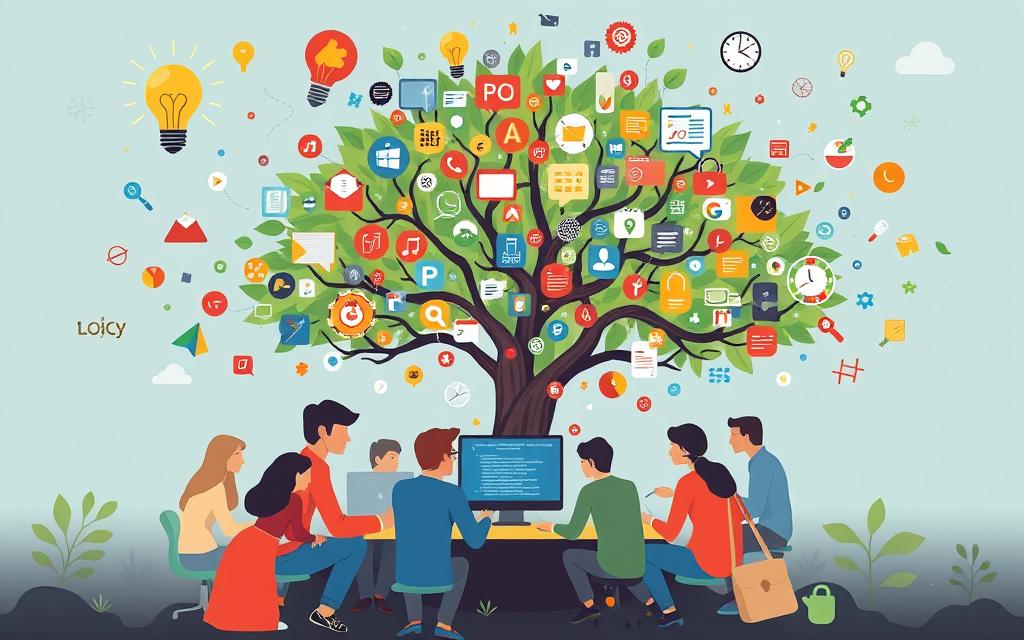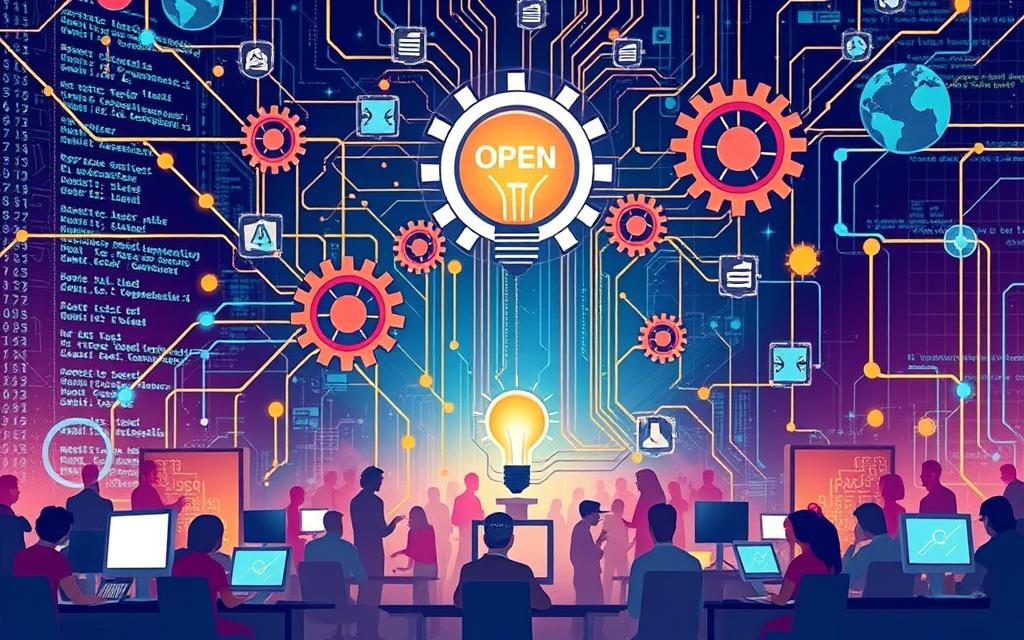Defining Open Source in the Context of Computer Science
Open source in computer science is more than a software model. It’s a philosophy that values teamwork, openness, and engaging the community. The open source definition in computer science means the software code is open for everyone to see, change, and share. It came from the idea that working together brings better results than working alone.
Historically, pioneers like Richard Stallman set the early stage for open source. They fought for ‘free software’, focusing not just on cost but on easy access to technology. They wanted to share knowledge and tools for everyone’s benefit. Open source encourages people to look at, improve, and customize the code, making it more useful and relevant.
Now, companies like Red Hat show that open source software can be profitable and beneficial. Open source methods like peer review and spread-out development make software stronger and longer-lasting. This is unlike closed software, which limits changes and sharing.
In summary, open source software is transforming the tech world by blending creativity with practicality. It creates powerful systems that meet a wide range of needs. For those curious about how programmers work with source code, you can find more information here.
Understanding Open Source Software
Open source software (OSS) is about working together, letting developers build apps openly and as a team. The idea is that anyone can look at, change, and make the software better. This approach brings together many ideas, making the software strong and able to meet new demands easily.
What is Open Source Software?
Open source software stands out because its code is open for all. Tools like Linux, LibreOffice, and the GNU Image Manipulation Program not only help users but also spark new ideas among developers. This brings fresh creativity and innovation to the community.
The Role of Source Code in Open Source
The source code is key to open source software’s success and growth. Developers can check, fix, and enhance the software, making it better over time. However, working together like this can sometimes lead to mistakes or security issues.
Open Source vs. Proprietary Software
Open source and proprietary software differ mainly in accessibility and control. Open source offers more freedom to change and share, unlike proprietary software. But, companies in fields like finance might prefer proprietary software for better compatibility and support despite its stricter usage rules.
| Feature | Open Source Software | Proprietary Software |
|---|---|---|
| Source Code Access | Available for modification | Restricted access |
| Cost | Free or low-cost | Licensing fees apply |
| User Control | High flexibility | Limited user freedom |
| Community Support | Active community involvement | Vendor-driven support |
| Ecosystem | Diverse and collaborative | Centralised and competitive |
Open Source Definition in Computer Science
Open source software has changed how computer science works. It encourages working together, sharing knowledge, and making things creatively. This moves us to look at how it started and the main ideas that shape it.
The Historical Context of Open Source
The story of open source began in the early days of computers when people worked together to make progress. The term came to life in the late 1990s. It aimed to make software easier to share for business use. Groups like the Free Software Foundation pushed for making software easy to get.
In 1999, the Open Source Initiative made rules for open source. These rules help us understand how open source works today.

Key Principles Behind Open Source Development
Open source is all about being open, working together, and involving the community. It uses a model where programmers share everything. This includes code and how to make things. It makes creating new things easier and faster.
This way of working helps lower the cost of getting to these creations. This leads to more people using and improving them. Economists think open source is special. It doesn’t cost much to make more of it, but it’s very valuable to users. Big projects like Linux and Apache Hadoop show how valuable open source can be. They are worth a lot and are a big part of the internet and computing.
The Evolution of the Open Source Movement
The open source movement started from the free software movement. Now, it’s widely accepted and used in technology. This change shows how software development is dynamic and works best with teamwork. It has greatly changed computing.
From Free Software to Open Source
In 1998, in Palo Alto, California, the term “open source” was born. It came after Netscape decided to share its Navigator browser’s code. This was a big change. It shifted the focus towards a clearer understanding of software freedoms. The Free Software Foundation, with Richard Stallman at the helm, started it all in the late 1980s with the GNU project. This project was all about the freedom to use, change, and share software. The move to “open source” was strategic. It aimed at making the ideas more attractive to businesses by highlighting the benefits of sharing code.
The Impact of the Open Source Initiative (OSI)
Bruce Perens and Eric S. Raymond founded the Open Source Initiative in February 1998. OSI has been critical in shaping the open source movement. It crafted the Open Source Definition from the Debian Free Software Guidelines. The focus was on making the software useful for businesses. This helped open source software become more popular across different fields. The legal side of open source also changed. Organizations like the Software Freedom Law Center started offering legal help. OSI’s work has led to a boom in community-based development and the growth of open source software in the late 20th century.
Benefits of Open Source Software
Open source software is a great example of how teamwork works wonders. It brings many benefits for both individuals and companies. These include saving money, working together with a big community, and being able to change the software as you need.
Cost-effectiveness and Accessibility
Using open source software is often free, which helps many people get access to advanced technology without worrying about costs. This means companies can spend more on making new things rather than on fees. Tools like Linux and MySQL show how open-source can be gentle on the budget but still powerful. An analysis found that around 30% of top companies have made special teams for using open source tools, showing how popular and useful these tools are.
Community Collaboration and Peer Review
The true value of open source software comes from its large, active community. Developers from all over join in, sharing their skills and making the software better and safer. This way of working together not only speeds up progress but also makes the software more reliable. Sites like GitHub are key places for community collaboration, where developers help each other, solve problems, and create new things together.
Flexibility and Control for Users
The best thing about open source software might be how it lets users control and change it. This means companies can make the software perfect for what they need. They’re not tied down by strict contracts, so they can try out different tools easily. Because of this, businesses can quickly adapt and stay ahead in their market.
| Benefit | Description | Examples |
|---|---|---|
| Cost-effectiveness | Lower initial costs due to the absence of licensing fees. | Linux, MySQL |
| Community Collaboration | Active participation from developers leading to improved software quality. | GitHub, Apache |
| Flexibility | Ability for users to modify and adapt software to their needs. | Ionic, React Native |

Conclusion
The open source model has changed many industries, not just software development. It promotes working together, being open, and creating new things. More and more, organisations are choosing open systems over closed ones. This shows the big effect open source has had, shaping how we see the future of technology.
Open source invites everyone to join in and learn together. It lets many developers help improve software by working as a team. Big projects like Linux, MySQL, and WordPress show us how open source leads technology forward. These projects prove how important community support is.
Open source’s role will keep growing, making the tech world better and more innovative. It’s key for those wanting to upgrade their development work. By knowing more about source computers and the best tools, their work can improve. Check out source computers for more information. The open future of open source is full of exciting opportunities we should all explore.
FAQ
What is open source software?
Open source software (OSS) is a kind of software that lets anyone look at, change, and improve its code. This approach boosts participation and leads to better software. Some well-known examples are Linux, LibreOffice, and the GNU Image Manipulation Program.
How did the open source movement evolve?
The open source movement began with the teamwork spirit of early computing. Richard Stallman created the Free Software Foundation in the 1980s. He wanted software to be free for all. Later, in the 1990s, this idea grew into the open source movement we know today.
What is the difference between open source and proprietary software?
Open source software allows everyone to see and change its code. Unlike proprietary software, which keeps its code secret and restricts its use. Open source is more flexible and often less costly.
Why is cost-effectiveness important in open source?
Open source software is often free, saving money for everyone from individuals to big companies. You might pay for support, but you save on license fees. That’s why many choose open source.
How does open source encourage community collaboration?
Open source thrives on teamwork and sharing knowledge. It lets people from all over contribute their skills. This way, technology gets better, and more ideas are shared.
What are the key principles of open source development?
The main rules in open source are being open, working together, sharing control, and involving the community. These ideas help bring out new solutions, making software better for everyone.











